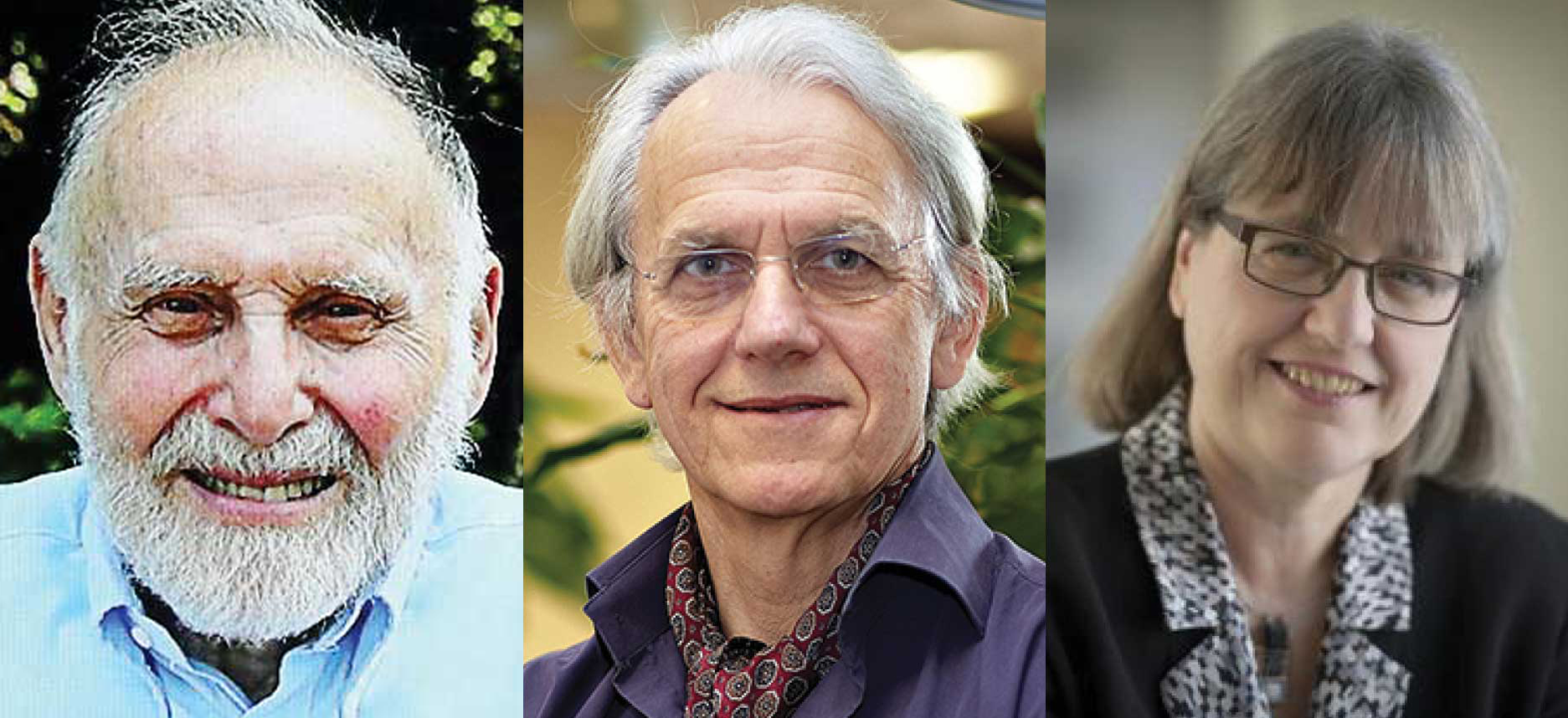By Leah Poffenberger
On October 2, the Royal Swedish Academy of Sciences announced this year’s winners of the Nobel Prize in Physics. Recipients of the 2018 prize, awarded “for ground breaking inventions in the field of laser physics,” are: Arthur Ashkin (formerly at Bell Laboratories), Gérard Mourou (École Polytechnique, France, and the University of Michigan, Ann Arbor, United States), and Donna Strickland (University of Waterloo, Canada). Strickland is the third female physicist to receive this award and the first to do so since 1963.

Bell Labs, ELSA, Univ Waterloo
Arthur Ashkin, Gérard Mourou, Donna Strickland
Half of the Prize goes to Ashkin for “optical tweezers,” a device for grabbing and manipulating small objects, and its application to biological systems. This work was first published in Physical Review Letters (PRL). The other half was jointly awarded to Mourou and Strickland for their method of generating high-intensity, ultra-short optical pulses. Both inventions represent major breakthroughs in the use of laser beams for practical purposes.
“Art Ashkin's beautiful experiments at Bell Labs inspired his fellow physicists to pursue laser cooling and optical traps, which in turn has led to degenerate quantum gas physics, laser tweezers for biophysics, and much more,” said APS Vice President Philip Bucksbaum of Stanford University. “Almost at the same time, Donna Strickland and Gérard Mourou solved a key problem in laser science that quickly opened the door for both attosecond science and high-powered lasers.”
Ashkin, an APS Fellow and recipient of the 2003 APS Joseph F. Keithley Award for Advances in Measurement Science, received the Nobel prize for his work at Bell Laboratories from the 1960s to the 1980s. There, he invented optical tweezers that use laser light to trap microscopic objects such as particles, atoms, and viruses. Optical tweezers are now used to capture and study living bacteria.
Mourou and Strickland developed chirped pulse amplification (CPA), a method of generating high-intensity, ultra-short pulses, when they were both at the University of Rochester. The scheme allows creation of powerful laser pulses that would otherwise damage the optical materials in the amplifiers. CPA is now a universally used laser technology and has paved the way for higher-intensity, ultra-sharp laser beams now used in millions of corrective eye surgeries. Mourou was the winner of the 2018 APS Arthur L. Schawlow Prize in Laser Science.
The concept of using lasers or light to move objects seems like something from a sci-fi film, but as Ashkin detailed in his 1970 PRL paper, focused, narrow beams of laser light generate optical forces that can displace small particles. Ashkin’s original experiments with tiny transparent spheres showed that particles would move to the center of a laser beam, where the intensity was greatest. Using this concept, Ashkin demonstrated the use of laser beams for three-dimensional trapping of particles, now known as optical tweezers, in a 1986 paper, also published in PRL.
Ashkin and his colleagues first used optical tweezers to trap atoms but the technique is now widely used to study biological systems. The researchers realized the potential for optical tweezers to capture and manipulate living cells and viruses without causing physical damage. The use of Ashkin’s invention has provided insight into the mechanics of fundamental biomolecular processes, like the process of protein synthesis based on motor RNA transcripts.
Mourou and Strickland’s development of CPA has also led to a variety of applications from plasma physics to medicine—for example, the brief, intense light pulses created with CPA are used in eye surgery for vision correction. CPA also represented a turning point in laser science, allowing a dramatic increase in intensity of lasers after progress had been mostly stagnant. Between 1970 and 1985, the number of photons in a laser pulse had not been substantially improved because higher intensities caused optical damage.
Inspired by radar technology, Mourou and Strickland conceptualized CPA, which overcame amplification issues, as described in a 1985 paper—Strickland’s first scientific publication. To avoid unhealthy intensities in the optical amplifier, the CPA technique separates the frequency components in a short light pulse and spreads them out over a longer pulse, thereby reducing the peak power. This stretched and “chirped” pulse is amplified, and then the frequency components are compressed back together, now with much higher intensity. The invention of CPA opened the field of laser physics to create increasingly intense beams for a variety of applications.
“There have been several Nobel Prizes associated with the development and application of lasers,” said 2018 APS President Roger Falcone, a laser physicist at the University of California, Berkeley. “This year it is wonderful to see recognition of Art Ashkin’s seminal work in using lasers to manipulate the motion of small particles, as well as Gérard Mourou’s and Donna Strickland’s impactful invention of a technique that enables the highest peak power lasers. The recognition of Strickland’s critical contributions as a graduate student is noteworthy and inspiring.”
The Nobel Prize, first awarded in 1901, is widely considered the highest honor in science, economics, and literature. The 2018 Nobel Laureates will be awarded medals at a ceremony in December, along with 9 million Swedish krona, half of which goes to Ashkin and the other half to Mourou and Strickland.
Additional Reading
A. Ashkin, "Trapping of Atoms by Resonance Radiation Pressure" Phys. Rev. Lett. 40, 729 (1978).
©1995 - 2024, AMERICAN PHYSICAL SOCIETY
APS encourages the redistribution of the materials included in this newspaper provided that attribution to the source is noted and the materials are not truncated or changed.
Editor: David Voss
Staff Science Writer: Leah Poffenberger
Contributing Correspondent: Alaina G. Levine
Publication Designer and Production: Nancy Bennett-Karasik
November 2018 (Volume 27, Number 10)
Articles in this Issue

